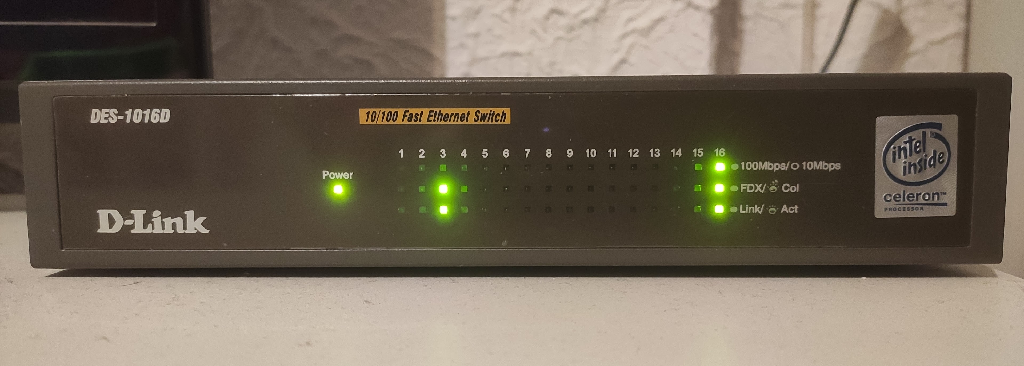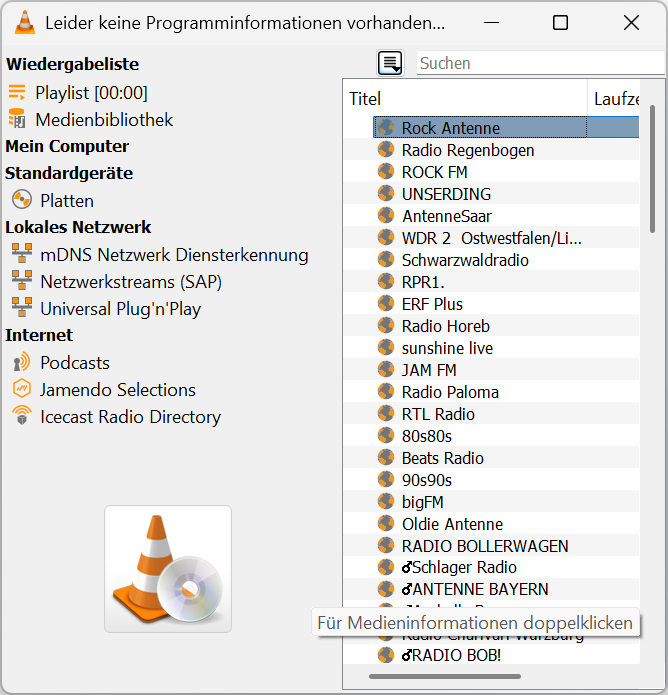Over the years, some exotic devices accumulate in the home network.
Some are closed to your heart from the very beginning, others only after a period of acclimatisation, when you are finally ‘room-clean’. And still others ... well, let's say so – good that there are classified ads. 8)
Let's start directly with one of the oldest living zoo residents:
An old, but well aged D-Link switch, I mean at that time via an intermediary/SME supplier in the neighbouring town from the fund of wave-computer.de – (the B2B compartment of Alternate) Orders somewhere, sometime in 1998/1999 for a comparatively large amount of DMark as a replacement for an 8 port 10/100 hub of 3Com.
D-Link DES-1016D
16 Port 10/100 FastEthernet Switch
Housing: Sheet metal, solid
Power supply: Cold equipment cable
Yes, correctly read, 10 and 100 Mbit Can do the good piece. Nothing else. No management interface, no additional functions, nix, niente, nada.
In the Datasheet it is still advertised that it has implemented a protocol in half-duplex mode, (CSAM/CD) prevent collisions. Now that leads too far. At that time it was really important.
Since it has accompanied my circle of friends and me through countless LAN party nights and has never failed in all these years until today, I hold it in honor. I mean, it's only about 27 years old and the US manual specified a MTBF of 492,096 hours – so we're only about halfway through.

Really active but the good piece is no longer, but it chills comfortably in front of itself. Specifically, it holds together a separate LAN guest network from a few multimedia devices. If you want the bread period for the zoo staff, which is defined by visitor flows. The Celeron sticker is by the way only decoration. It's probably just a tiny Atmel or Broadcom chip. Believe the piece of jewelry does not need 5 watts even under full occupancy.
Once again fixed to the Datasheet, at that time there were still printed manuals and felt that even effort was made, that was the entry:
Congratulations on your purchase of the DES-1016D 16-port
10/100Mbps Auto-negotiation Fast Ethernet Switch. This device
integrates 100Mbps Fast Ethernet and 10Mbps Ethernet network
capabilities in a highly flexible package.
Unfortunately, I did not find that for my early revision, but only one for the almost identical successors, but at least.
This couple has also moved into the zoo almost from the beginning – or at the beginning of the 2000s. Actually nothing special but probably that's exactly why I'm accompanied by a sentence of the legendary, perfectly fitting for my ears.
JBL Control One
Active loudspeakers
Model: 1G
75W sine
4 ohms
On PC you find or found earlier rather Soundblaster cards and Logitech or Creative speaker sets, in some cases 2.1 is still common there even now, if you look around at Idealo or miserly.
At the time, the Control One also replaced a Logitech set.
The sound output into a HiFi amplifier and from there back into shelf speakers was a quite common PlanB. What broke on the original set I can not even say today, but except for my daughter I never had to buy PC speakers again after the JBL.
Okay, there's not all peace, joy, cake. At some point everything in the middle and in the bass area suddenly sounded very scratchy and unclean. About headphones everything was chic, amplifier and cabling everything was iO. Let's put it this way: With the exception of 1x shaking when beading re-adhesive in the 2010s a product which is not to get dead.
Also very old but somehow a clever survival artist is my
Razer Diamondback
Model: RZD-1600
Magma look
Nowadays hardly considered as a unique selling point, the 1600 DPI were then 2004 the selling point for gamers, the semi-transparent magma look at the same time far before the general RGB trend also visually the hit and both in processing and handling the mouse (with cable attached) really a gem.
The reason the Razer has survived all these years? It has only gotten older most of the time as a backup in drawers, in the meantime I have probably worn out more than half a dozen other mice ‘in normal operation’ and probably a similar number of keyboards.
However, I stumbled on the transport bag at some point. It's a pity.
Something new but for IT conditions also with long, gray beard accompanies me a mobile data carrier from the company Maxtor, my
Maxtor Basics Desktop Storage
External hard drive
Model: 1000GB
9NZ2D8-500
Definitely no longer at the level of time but always reliably performs its service over years. This device is almost also a trained professional because originally the external hard drive comes from Ireland.
Ordered online at Elara.ie at the end of 2008 / beginning of 2009 in order to have a convenient way to quickly transport even larger data back and forth without transporting a laptop or entire PC directly each time, this disk has also become the central storage location of my current PC image over the years, as part of the 3 / 2 / 1 backup strategy (transfer of the data to another physical location, the so-called offsite backup). Only the IE/DE power plug adapter was a bit bulky.
Since this has meanwhile become not so essential anymore, especially due to the almost everywhere sufficient availability of fast Internet connections, the record now enjoys the evening of life on my window silhouette with a view of the garden.
Even before I worked intensively with computers, this piece of jewelry was already on the market and has always retained its charm in all these years. We are talking about quasi ‘the keyboard’, the durability and reliability miracle
Cherry G83
Wired keyboard
Model: G83 / USB
in plain black
Keyboard layout: Franconian
As a souvenir of the beautiful time here with Franconian keyboard layout (yes, I was weird then – and I don’t mean ha-ha weird) Cherry emigrated with me and later came home.
As an almost identical successor to the RS 6000 series with PS/2 connection, the G83 with USB is probably still usable after a nuclear war. I can't remember a keyboard that has been treated so badly by me over the years and yet has continued to perform its service stoically.
From my point of view, the Internet's beginnings were already over, I just noticed the modem time actively on the edge with 56k, very quickly ISDN was already available instead (Hello AVM FritzCard PCI) and also from there to the first DSL connection, the time passed as if in flight and in this course the
FRITZ!WLAN Repeater DVB-C
Wlan repeater +
DVB-C feed-in point
TV and radio streams on any device, conveniently without tinkering or extra hardware, purely via Ethernet? Runs since 2014/2015.
The easiest way is with the VLC player. Search for stations, download a list, open it in VLC and everything is ready. Admittedly, even if even before the pandemic only in homeopathic doses on TV, there is just garbage.
But what is still well and gladly used is the streaming of the radio stations in the home network!
This is what ‘live’ looks like – export from the repeater and import into VLC:


The repeater is now also redundant, because since the Internet itself runs completely via cable connection, the feed-in can also take over the standard cable Fritz.Box. Thus, this Fritz now depends only in the break room with the colleague D-Link. The good news is that the 2.4Ghz cover extends to the last corner of the garden. So move on, move on!